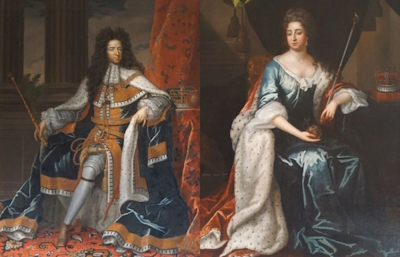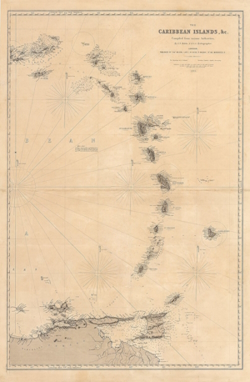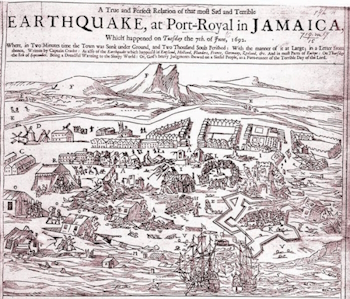 The ‘Glorious Revolution’, or de Glorieuze Overtocht in Dutch, is often called the Bloodless Revolution as there was very little bloodshed in England itself, although in Ireland it was a particularly bloody affair. Most ordinary people weren’t directly affected by the invasion as they had been during the Civil Wars (1642-52). In his book The King Over the Water, Desmond Steward said of it: “The events of 1688 were not so much a revolution as an aristocratic coup d’etat that ended in a one party state …” The events of 1688 were probably more significant politically for England than the Civil Wars as there were very few real changes to the system after the latter. Although William was invited to take the throne by some notable English figures, his arrival on British shores is still viewed by many as an invasion of England by the Dutch to remove a potential ally of Louis XIV of France.…
The ‘Glorious Revolution’, or de Glorieuze Overtocht in Dutch, is often called the Bloodless Revolution as there was very little bloodshed in England itself, although in Ireland it was a particularly bloody affair. Most ordinary people weren’t directly affected by the invasion as they had been during the Civil Wars (1642-52). In his book The King Over the Water, Desmond Steward said of it: “The events of 1688 were not so much a revolution as an aristocratic coup d’etat that ended in a one party state …” The events of 1688 were probably more significant politically for England than the Civil Wars as there were very few real changes to the system after the latter. Although William was invited to take the throne by some notable English figures, his arrival on British shores is still viewed by many as an invasion of England by the Dutch to remove a potential ally of Louis XIV of France.…
Category: Historical
King William’s War
 The name King William’s War was given to the American theatre of operations in the Nine Years’ War. It was probably named so because the war broke out when William III ascended to the throne of England and because of the financial interests he held in the Hudson Bay Company. It was fought on a much smaller scale than in Europe. One area of contention was the fur trade in the colonies, another was Caribbean trade. England and Spain, who were traditionally enemies in the Caribbean, were now allied against France, but although the Allies had for the most part the naval advantage in this region, it proved impossible to keep the French from supplying their colonial forces.
The name King William’s War was given to the American theatre of operations in the Nine Years’ War. It was probably named so because the war broke out when William III ascended to the throne of England and because of the financial interests he held in the Hudson Bay Company. It was fought on a much smaller scale than in Europe. One area of contention was the fur trade in the colonies, another was Caribbean trade. England and Spain, who were traditionally enemies in the Caribbean, were now allied against France, but although the Allies had for the most part the naval advantage in this region, it proved impossible to keep the French from supplying their colonial forces.
Nine Years’ War
 The Nine Years’ War, which took place from 1688-1697, was also known as the war of the Grand Alliance, or King William’s War in the Americas. The Grand Alliance was formed by England, the Dutch Republic, and the Grand Duchy of Austria, later to be joined by others, including Spain and Savoy, to oppose Louis XIV’s expansionism on the Rhine and in northern Italy. Louis XIV’s anti-protestant policies, in particular the persecution of the French Huguenots, also made him unpopular with protestant rulers in Europe. This war also sometimes mistakenly referred to as the War of the League of Augsburg after the coalition formed in 1686 by Emperor Leopold I, the kings of Sweden and Spain, and the electors of Bavaria, Saxony, and the Palatinate against the increasing French threat. Louis XIV also made himself unpopular in England by lending his support to the Jacobite cause of the deposed James II of England, attempting to instigate a Catholic crusade to restore James to the throne.…
The Nine Years’ War, which took place from 1688-1697, was also known as the war of the Grand Alliance, or King William’s War in the Americas. The Grand Alliance was formed by England, the Dutch Republic, and the Grand Duchy of Austria, later to be joined by others, including Spain and Savoy, to oppose Louis XIV’s expansionism on the Rhine and in northern Italy. Louis XIV’s anti-protestant policies, in particular the persecution of the French Huguenots, also made him unpopular with protestant rulers in Europe. This war also sometimes mistakenly referred to as the War of the League of Augsburg after the coalition formed in 1686 by Emperor Leopold I, the kings of Sweden and Spain, and the electors of Bavaria, Saxony, and the Palatinate against the increasing French threat. Louis XIV also made himself unpopular in England by lending his support to the Jacobite cause of the deposed James II of England, attempting to instigate a Catholic crusade to restore James to the throne.…
The 1692 Port Royal Earthquake
“…the great Calamity that hath befallen this Island by a terrible Earthquake, on the 7th instant, which hath thrown down almost all the Houses, Churches, Sugar-Works, Mills and Bridges, through the whole Country. It tore the Rocks and Mountains, destroyed some whole Plantations, and threw them into the Sea, Port-Royal had much the greatest share in this terrible Judgement of God.” – Dr. Emmanuel Heath, Anglican rector of St. Paul’s Church, Port Royal
 In 1692, Port Royal was the main British base in Caribbean, which had been captured from the Spanish in 1655. The town became a thriving centre of trade and privateering, but by 1692 the focus had shifted to the cultivation of tobacco and sugar cane with an increased growth in the slave trade. Port Royal was built on a peninsula off the coast of Jamaica across from present-day Kingston and was religiously and culturally very diverse. At its height in 1692, the population of the town is estimated to have exceeded 6500 inhabitants, of which about 2500 were slaves.…
In 1692, Port Royal was the main British base in Caribbean, which had been captured from the Spanish in 1655. The town became a thriving centre of trade and privateering, but by 1692 the focus had shifted to the cultivation of tobacco and sugar cane with an increased growth in the slave trade. Port Royal was built on a peninsula off the coast of Jamaica across from present-day Kingston and was religiously and culturally very diverse. At its height in 1692, the population of the town is estimated to have exceeded 6500 inhabitants, of which about 2500 were slaves.…
The Great Storm of 1703
“No pen could describe it, nor tongue express it, nor thought conceive it unless by one in the extremity of it.” – Daniel Defoe, The Storm
 The Great Storm, a force two hurricane with wind speeds of up to 95 miles per hour, hit the south of England and Wales on 26th November 1703, the strong winds finally abating on 28th November. The Church of England declared that the storm was God’s retribution for the sins of the nation and it couldn’t have hit at a worse time. That year saw the greatest concentration of both naval and merchant shipping on the British coast to that date. Due to The War of Spanish Succession merchant ships were forced to travel in escorted convoys for safety against the attacks of French privateers. Three such convoys were anchored in Milford Haven, the Kentish Downs, and the estuary of the Humber when the storm hit.…
The Great Storm, a force two hurricane with wind speeds of up to 95 miles per hour, hit the south of England and Wales on 26th November 1703, the strong winds finally abating on 28th November. The Church of England declared that the storm was God’s retribution for the sins of the nation and it couldn’t have hit at a worse time. That year saw the greatest concentration of both naval and merchant shipping on the British coast to that date. Due to The War of Spanish Succession merchant ships were forced to travel in escorted convoys for safety against the attacks of French privateers. Three such convoys were anchored in Milford Haven, the Kentish Downs, and the estuary of the Humber when the storm hit.…
